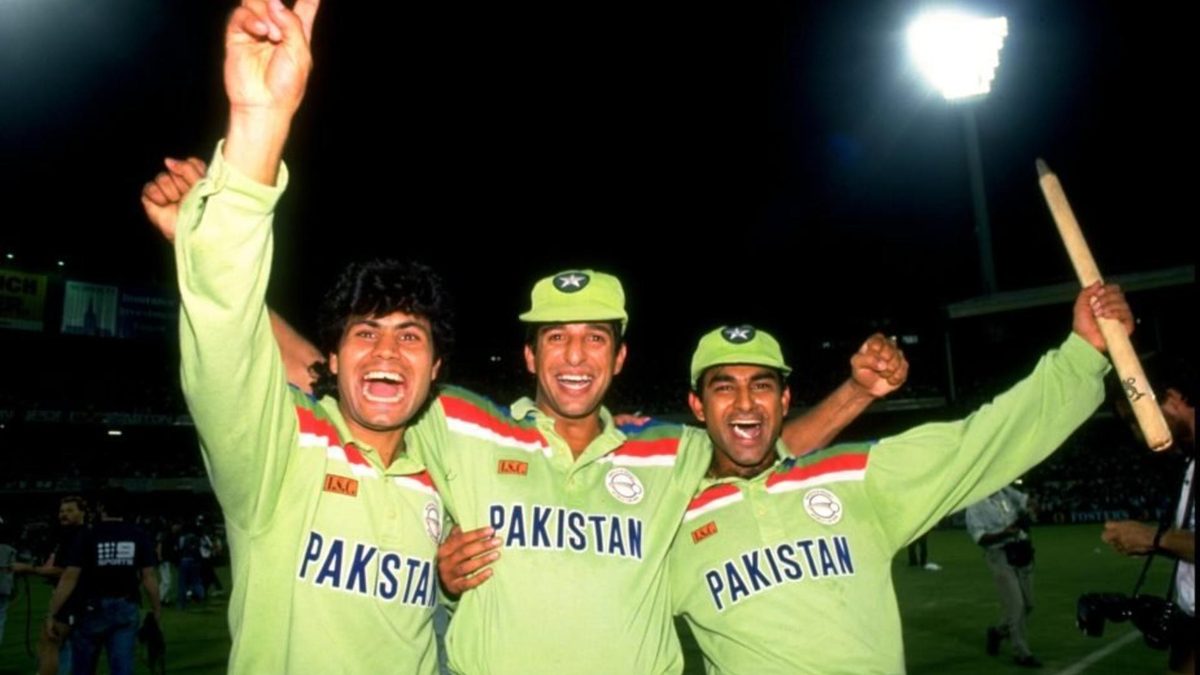
Osman Samiuddin looks for cultural answers to why Pakistan can turn it on like no other team in world cricket
Originally published in 2013
One November night in Sharjah, Kumar Sangakkara and Mahela Jayawardene came together to do what they had been doing for what now seems like forever. It was a warm, oily evening, the air heavy and lubricated. The pair had joined forces at 53 for 3, chasing 201 for the win. The pitch was a grubby orangey-brown, where batsmen were regularly through their strokes too early. Pakistan were 2-1 up in the series and playing in a recrudescent stadium, but this was still pretty routine firefighting for the Sri Lankan pair.
Neither batsman was comfortable to begin with because you couldn’t really be on that surface. But once they got past the first 20 minutes, the familiarity of the task took over. Boundaries were bonuses – only three came in 17 overs from the 18th onwards – so, like good traffic cops, they simply kept the flow moving along. Single here, double there, single here, double there, nice and steady. By the 38th over, they had put on 102 and were looking as settled as two old buddies watching the game on an old, much-shared couch.
Sri Lanka now needed just 46 with 74 balls still to come (the required run-rate wasn’t high, but the nature of the pitch made it a little steeper). The crowd, largely Pathan, were still pretty cheery but attention from the match had slipped, and was focused on the occasion itself; Pakistan were, after all, returning after many years to a venue where they had created love and magic and darkness.
We were sitting in the press box which, in the revamped stadium, was at Sangakkara’s long-on when, from around the wicket, Shahid Afridi skipped in to bowl his sixth over. He’d had an eventful game and an even more eventful but inactive six months preceding the series. In that time, the Pakistan Cricket Board (PCB) had stripped him of the limited-overs captaincy after he made public a dispute with Waqar Younis, the coach at the time with whom his relationship had always been the wrong side of edgy.
It went the way all big feuds in Pakistan cricket do. It became legal after the PCB, in a fit of pique, stopped Afridi from playing for Hampshire. Then it became political, Afridi pooling the many cards permanently at his disposal – Pathan by birth, a lifelong Karachiite, the land’s most popular cricketer, a true celebrity and among their best limited-overs bowlers in recent years – and bringing them to bear down on the board. The interior minister got involved, as did the President (rumoured only, and in the kind of detached way he is said to be ultimately involved in everything, at the level of invisible ombudsman).
Compromises were reached, petitions and objections withdrawn. Afridi, who had “conditionally” retired in protest, eventually withdrew his retirement but only after Ijaz Butt had been replaced by Zaka Ashraf as board chairman. Now in his fourth game back, he’d first steadied Pakistan with the bat: his 75 from 65 balls, plump with loudly cheered singles and doubles, meant Pakistan survived being 97 for 6. The innings was slow by Afridi’s standards but his best and most mature in some time.
Now he came in, shining with sweat, and angled one in. First he beat Sangakkara on length, the batsman pressing then pushing forward but realising he wasn’t forward enough. Then his leg-break spun, which doesn’t always happen, zipped through Sangakkara’s attempted drive and bowled him. Chewing gum, Afridi turned around and produced his trademark, star-man celebration. It was muted though, chest not as far out, legs only slightly apart. There was less gusto, more the resignation of a man who’d done a hundred takes of it already and this, really, was just one too many. Apart from the wicket-keeper Sarfraz Ahmed, happy just to be in the side, none of the players who gathered around Afridi looked overly chuffed.
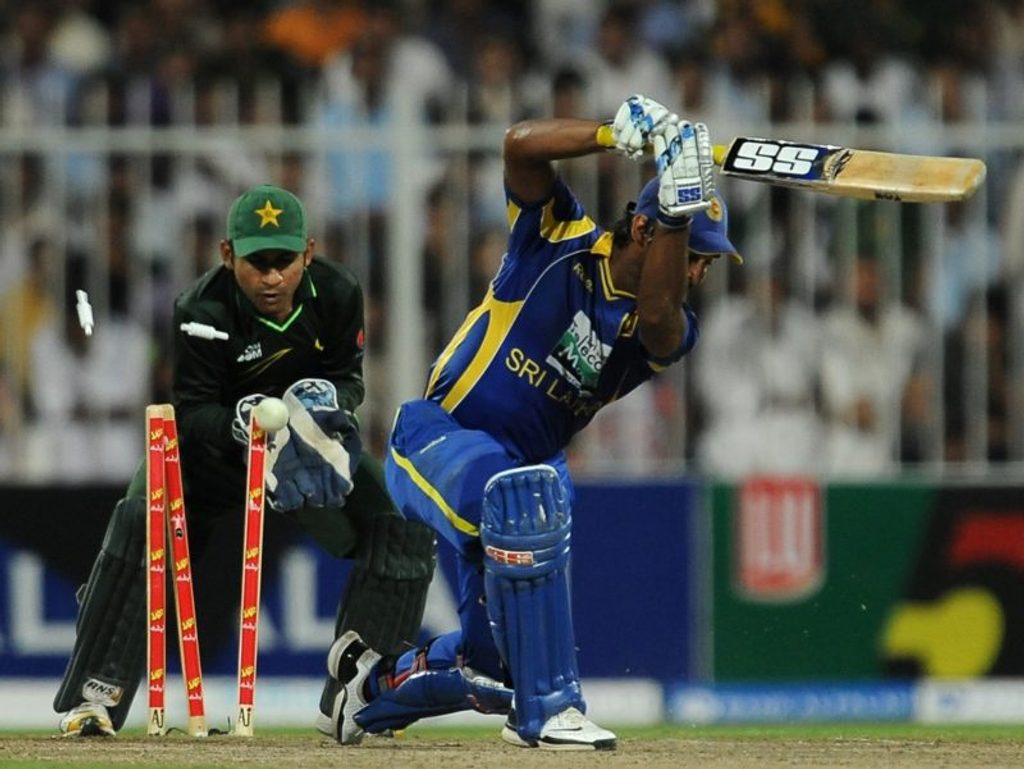 Kumar Sangakkara is bowled by Shahid Afridi during the Sharjah ODI in 2011
Kumar Sangakkara is bowled by Shahid Afridi during the Sharjah ODI in 2011
In the press box I turned to Shahid Hashmi, the AFP sports stringer for Pakistan, and we both silently acknowledged a possibility. We did it knowingly, but without knowing precisely what we were being knowing about. As most agency guys would have done, he’d already prepared much of his copy, reporting a comfortable Sri Lanka win. Only the details needed to be put in. Now we looked at each other and he decided, just to be safe (which, as a rule for agency writing, is top five), to start writing an alternative version, describing a Pakistan win.
On air in the commentary box was Waqar Younis and he left behind a thought that, like a trail of cigarette smoke, hung around deliciously. “Has this come too late or is there a twist in the tale?” A few days later we were discussing the game and that moment in particular. “I was doing commentary and I said it very clearly on air, what I am saying to you right now, I can sense something here, we just need one wicket,” Waqar said. “When Sanga got out, I said OK. Roshan [Abeysinghe] was with me and he said, no it’s over. They showed some girls praying, he said those prayers aren’t going to work. I said hold on, I can sense something here. Just one more wicket here and you watch this game, seriously, you watch this game.”
Indeed the game demanded watching. The night gave in to Afridi and Pakistan. He had been limping until then, the result of a nasty knee injury picked up while fielding that had forced him off the field and put in doubt his further participation. But now he took four more wickets. Sri Lanka lost seven for 19 including Sangakkara’s wicket in around seven overs to lose a game they had won in everything but the actual winning, by 26 runs. Hashmi sent in his copy, complete with alternative opening and end, on the dot of the last ball.
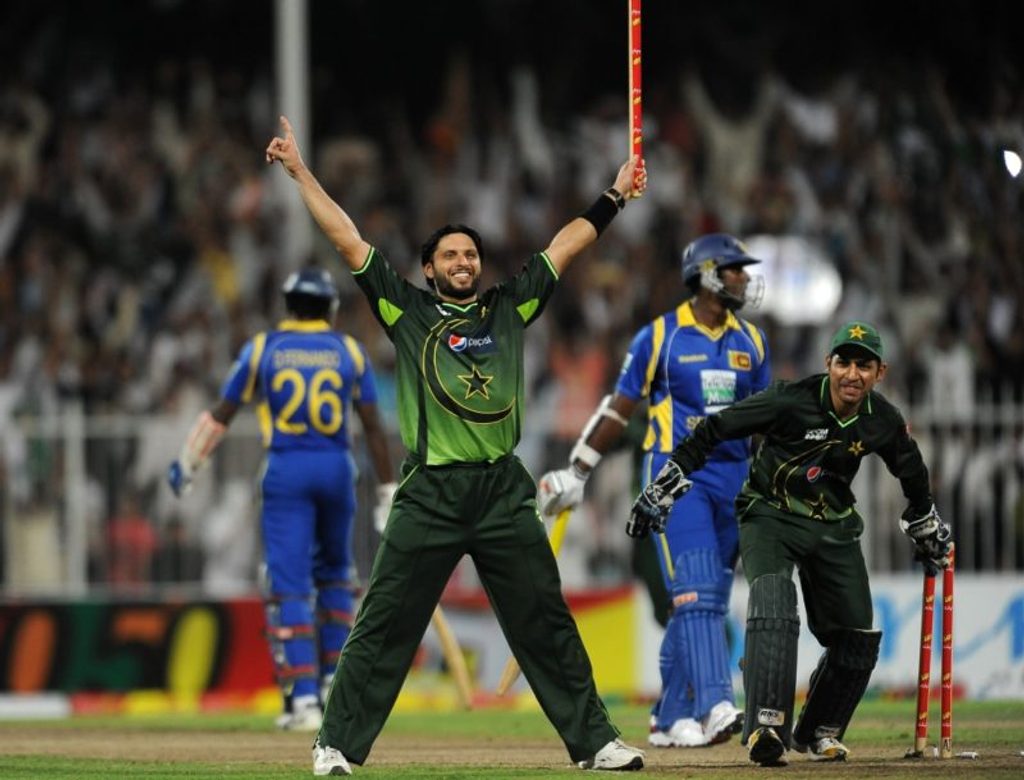 Shahid Afridi celebrates taking the final Sri Lanka wicket to win the ODI at Sharjah in 2011
Shahid Afridi celebrates taking the final Sri Lanka wicket to win the ODI at Sharjah in 2011
A week or so after the game, I met Younis Khan for an interview and asked him about the turnaround. “See, this is the tradition of Sharjah. Janaab-e-Aala [Gentlemen], 25 runs are needed and [Abdul] Razzaq and Azhar Mahmood come and take four wickets, three wickets, or Wasim Akram comes on and puts in a spell… this is a tradition we keep alive.”
I don’t know how or why it was that I, like Hashmi and Waqar, sensed the continuation of this tradition at that precise moment. There was no sound reason for it. Even after that wicket, Sri Lanka could and should have coasted it. But millions of others had it as well, probably, a fleeting feeling when Sangakkara went that Pakistan were about to turn it on, a feeling as real as a smell you smell, a sound you hear, a taste you taste and a dance you dance.
***
What we know about what happens, roughly, is this. Pakistan are in the field (almost exclusively so), drifting, amiably and contentedly, to defeat over five days, or one. They are comatose flat. Bowlers, uninspired, are on autopilot, the fielders heavy and ponderous. If there is a target, it’s down to, say, 45 off the last 10 with seven wickets in hand. If it’s a Test, the target being chased is a small one, under 200, or if it is the first innings, the opposition are 200 for 2. Coasting.
Sometimes, but not always, it takes an unusual dismissal to turn on the light – a run-out, an electric catch, a part-timer taking a wicket. And then there is total frenzy, so overwhelming and real you can almost hold it in your hands. Such is its force that it can be deeply moving even through the sensory dilution and sanitisation of TV, even on ball-by-ball commentary online. But to let it get right inside your head and start rearranging your brain – like acid but a lighter, less paranoid burn – you have to be there as it happens.
There is music, not heard but felt, a beat somewhere in the background, rising, unrelenting. Up front is the dissonance of a reality that is proceeding swiftly but with an impact that is unveiled languorously. Wickets begin to fall in heaps, twice, thrice in an over and each one seems the only logical conclusion to that particular spell of play. There is an appeal almost every ball, most justifiable. Fielders start hitting the stumps and taking catches which, in other situations, we can easily imagine them dropping.
If you’re a Pakistani, to watch this phase is to be removed into the elemental tape-ball game you might’ve played at the weekend in some street somewhere which only has a field on the leg-side. It is a devolved version of cricket; amateur, random, frantic. There is no ICC code, no strategy, no rules, no coaches, no support staff, no coaching manuals, no formality.
Pakistan begin to inflict their own chaos on the opposition, except that where they are using it as a force for good, the opposition is crumbling under the weight of it. If one moment accurately captures this frenzy – not the skill or beauty of it, but just the two-sided chaos – it is the run-out of Jonty Rhodes in an ODI Pakistan played in Durban in February 1993.
Pakistan had limped to 208 in their innings and South Africa were cruising, first at 101 for no loss, then with 10 overs to go, when they needed just 50 with nine wickets in hand. Asif Mujtaba, of all bowlers, began the collapse and by the time Rhodes fell – the sixth wicket – the show was in full, uncensored flow. Brian McMillan plays and misses at a Wasim Akram delivery. Spooked by the collapse, Rhodes tries to sneak a single. The wicket-keeper Rashid Latif, alert to this now, hits the stumps with an underarm throw. McMillan is safe but Rhodes has just arrived at the same end and, defeated, runs on, his fate decided.
Akram has run halfway down the pitch and appeals to nobody in particular as the stumps are broken, maybe just celebrating a direct hit. Realising that it isn’t a run-out but instead an opportunity for one at the other end, he starts running back. Mujtaba comes jogging in from point, still aware, picks up the ball and lobs it gently and high to the non-striker’s end. There, along with the retreating Akram, are now assembled Mushtaq Ahmed, Salim Malik and Inzamam-ul-Haq. They look like people who congregate around a road accident in the subcontinent within a second of it happening with nothing to offer but curiosity: haanji [yes, so] what’s happening?
Mujtaba’s lob is a little high for Akram, who has to leap to get it as he’s backpedalling, his momentum carrying him past the stumps as he grabs the ball. Momentarily, as he turns and finds no stumps in front of him, there is panic. Meanwhile, Malik also tries to catch the ball behind Akram – just to make sure? – and as he moves back he hits the stumps, nearly falling over, and knocks the bails off. More panic. Luckily little Mushy is at hand logging everything that is going on (Inzamam, as always, is inert) and he deliriously points Akram to the stumps: “Behind you, behind you!” as if Akram may not recognise the three stumps he’s been bowling at for the better part of his life.
Akram plucks out a stump and gleefully taps it with the ball, relief, elation, adrenaline all coiling into one another. Rhodes is halfway back to the hotel by this point, unaware of the mess he has left behind. It’s YouTube gold (type in “Waqar Younis 5 for 25 vs South Africa 1992–93” and go to 6:47). Put it in black and white and it’s a Three Stooges out-take (and check out the contrast with the pristine, natural athleticism of the next run-out, again Akram; the story of Pakistan cricket in two run-outs).
Waqar calls these moments a tamasha, a spectacle, but also a cross between a rolling circus and a fair. “I don’t think you need anyone at that time to calm you down because if somebody calms you down, you just break the rhythm. The other day, when Afridi and Saeed Ajmal was happening, thak-thak-thak it was going, you don’t need anyone to come and say ‘no, no, we need to do it like this or that’. Misbah was just sitting waiting, letting it run: ‘Tamasha lag gaya he, chal ne do isse [let the tamasha run]’.
“And it is a tamasha. I swear to God, we used to say it, we used to talk about it like this. Chal para kaam, chaloji, pakro [‘It’s begun, come, grab on to it’], that kind of language in the middle.”
To the spectator, the entire passage can be supremely disorienting, the head buzzing like a mobile phone on silent. You’re trying to understand what’s happening in front of you – how it’s happening, when it started happening, how it will finish, will it ever finish, do you even have time to enjoy it – and before you know it, it’s over and you’re sitting there stunned, like the first reaction to death and not knowing how to react and you’re alive and flushing and you’re a fool because it’s happened already and it’s over… and what the fuck just happened?
WTF just happened is that Pakistan did a Pakistan, a tamasha that is so unique and delirious and Pakistani, that it says something specifically about them.
Pakistan doing a Pakistan represents the occasional triumph of raw over manufactured, of organic over processed, of individual craftsmanship over mass production. That is to appreciate it. To understand it? That is important because we’re talking here about moments or days during which life doesn’t work as we know it should.
There are rational ways to look at this, no less compelling for their reasonableness. And each incident has its own specific context. After the Abu Dhabi Test win over England in 2012, when Pakistan bowled them out for 72 (defending 145), Misbah-ul-Haq rationalised how they had done it (he seemed also to be consoling England): fourth-innings targets, you know, always tricky no matter how small; five days’ worth of pressure aggregating itself in one chase; struggled against spin, and so on.
In the ’90s these passages of play came to personify the Pakistan side so much, in England, Sri Lanka, in the West Indies, in Sharjah, in New Zealand (especially and always New Zealand), they became so abundant that it looked like it was happening to formula. It was the unplanned plan: wait for the ball to become old (or make it so), get it reversing, hand it to either Wasim or Waqar or maybe one of the new kids who’s just come in but was born with balls of steel and knows just what to do with the ball. And then watch the tamasha.
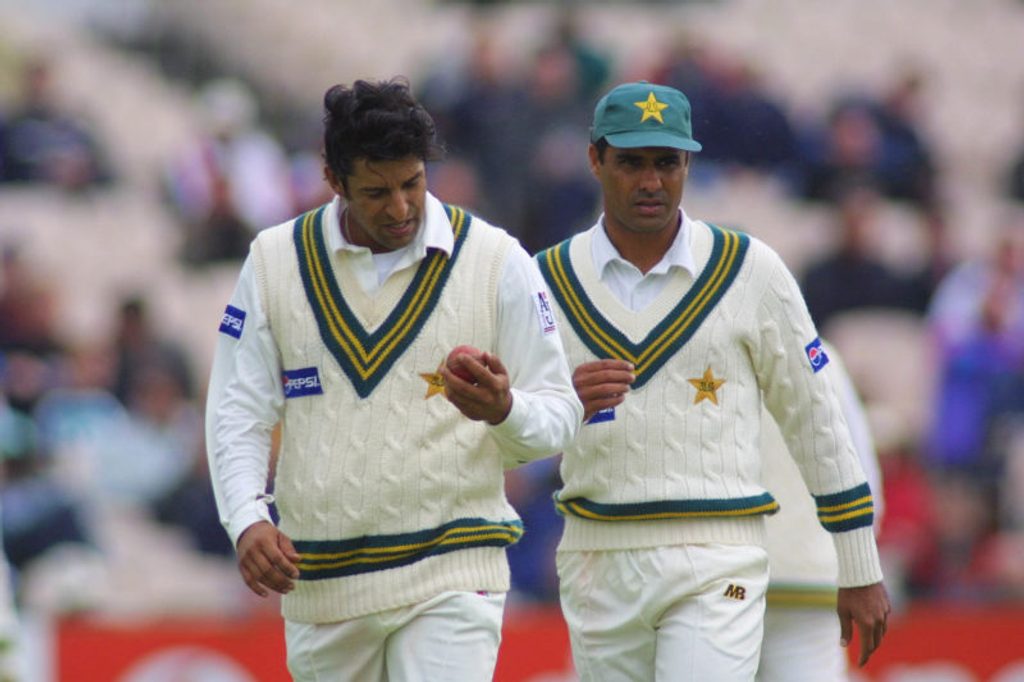 Wasim Akram and Waqar Younis, two masters of reverse swing with a combined 787 Test wickets
Wasim Akram and Waqar Younis, two masters of reverse swing with a combined 787 Test wickets
Alongside Wasim, Waqar remains the most vivid ringmaster of the tamasha and as he’d also just had a productive stint as the side’s coach, I asked him to make sense of it. “I tell you what, you know why this happens?” Waqar begins. “Because we’ve always had match-winners, individual match-winners. Not the team. Our team used to be titther-bitther [literally meaning scattered, but in this sense disunited and disparate] in the early days but there were guys like Wasim, myself, Inzi, Saeed Anwar, you know, one-man-show kind of players. We used to have so many that we would never lose hope.
“Even the game you are talking about, the Total Trophy, 40 runs with seven or eight wickets left… I still remember. I remember very few things from the ground, some big wickets of course, but there are certain things you do remember. I ran when Kirsten got out to Mujtaba, I ran to the guys and said, look, they need 40 runs, we need seven wickets, but we can see a window, there is a window. I said, it’s one wicket, the ball was swinging, new batsmen, no chance.”
Pakistan’s traditionally rich variety of unorthodox bowlers also means they pounce on new batsmen like no other side in the world. But in that situation, before it happens, why are they so flat?
“No, no, it’s not flat. It’s a waiting game. Sometimes in any game when the momentum goes to the other side, the fielding side becomes a bit flat. But we knew, back of our minds, every guy, Wasim, me, Inzi, Moin, even he could see and sense those small things, that there is an opportunity. Suddenly, jaan aajati he [you become alive]. When you have match-winners, when your bowler senses something, then your fielders pick up on it, they go along with them, you can see, you can see it in the eyes.”
You could tell that day in Durban?
“Not just in that match, but in that series, where Wasim also got five wickets in East London and they needed 30-odd runs in a similar situation, and thak-thak-thak, gone. You can sense those things. That was us.”
But how have Pakistan been so good at doing this?
“We’ve never given importance to coaching. We were never analytical or scientific. That guy is there [he points to the video analysis man on the dressing-room balcony], yeah sure he’s there. And he’s sitting there, and it’s kind of a highlights package and you can sit and analyse moments. But actually in the ’90s we never did analyse anyone: ‘he plays well here, don’t put it there.’ It’s not how long do you bowl at him there, what kind of field, what lengths, what is the B plan, the C plan, after that if it goes wrong, what happens? We had one plan. Go out there, get a wicket. We had resources. We sensed it and said, OK, bring Waqar back. Not even the captain [decided]. Sometimes I would go to the captain, give me two overs, let me do it. It was a kind of teamwork within the team but not like we’ll have a plan from before.
“No other country does it. Match-winners are always handy. Shoaib Akhtar? Match-winner. He’ll be ugly throughout the game, but with one or two overs he’ll change it, one spell. That’s why you play those characters. You can’t put the game in a shell where you have to be calculating, or planned or on this laptop, seeing how often this guy has gotten that guy out. Don’t do that.”
And then, quite unprompted, he inadvertently revealed just how powerful a thing it is to be part of (or, unsaid, to watch). He spoke of it like someone who’s gone cold turkey.
“It’s that thrill I miss, you know. If you ask me what I miss about cricket, I don’t want to go out and bowl again because I’m dead tired. But I miss that part, the thrill… in that [South Africa] match, we were so hyped up, so much adrenaline was pumping. When we got back to the hotel, my eyes were swollen. I had to go to a doctor, there was so much there. That I miss, that rush of blood.”
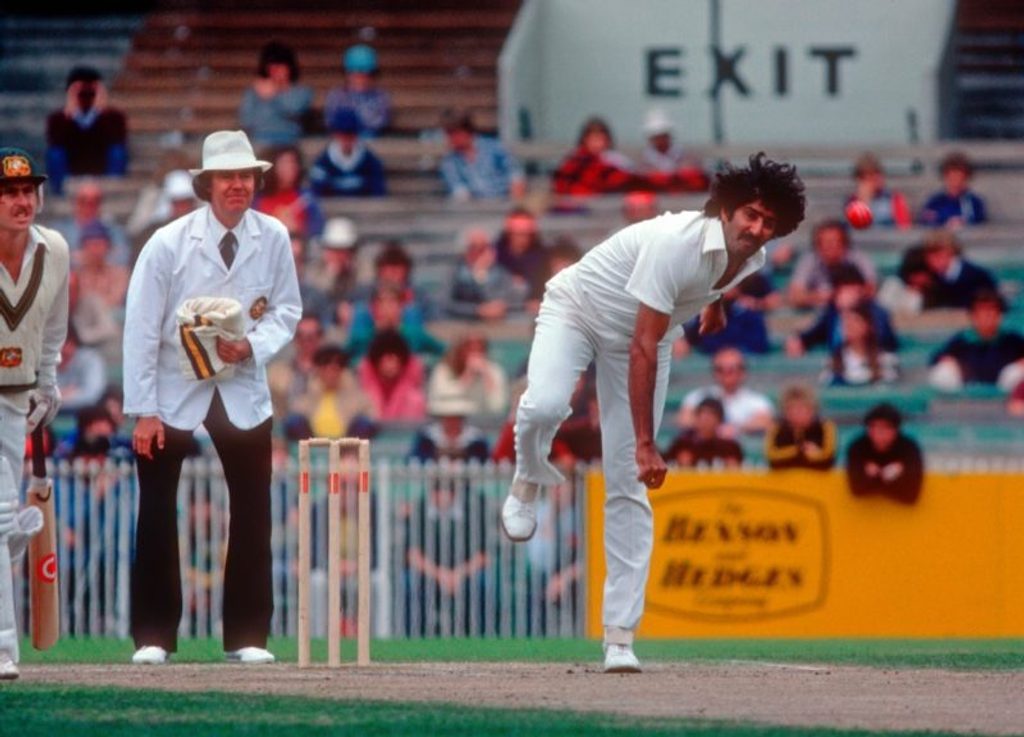 Sarfraz Nawaz playing for Pakistan against Australia in 1981
Sarfraz Nawaz playing for Pakistan against Australia in 1981
But the easiest mistake to make would be to assume that this is only about the pressure of fourth-innings totals, or the ability to reverse, or even that this is a recent manifestation. Take Sarfraz Nawaz’s spell of 7 for 1 in 33 balls in Melbourne in March 1979 (just repeat that slowly to yourself, roll it around your head slowly like some fine wine to fully appreciate the flavour: yup, it’s that crazy a spell). Not only is it commonly thought to be one of the first sightings of reverse swing as we now know and love it, but it’s also one of the most startling instances of Pakistan doing a Pakistan: Australia were coasting at 305 for 3, chasing 382 for victory. Soon they were all out for 310.
The only thing is, it’s not so clear if it was reverse swing. The frazzled footage available of it does reveal swing, and late swing in particular, but it’s not conclusive. Wisden Cricketers’ Almanack records that Allan Border and Kim Hughes, in putting on 172, had “carried on steadily through the second new ball and until half an hour after tea, when Sarfraz bowled Border off a deflection with a beautiful ball that cut back sharply.” That dismissal began the slide and it seems the ball was oldish by then. In his autobiography, captain Mushtaq Mohammad freely admits that players gave “the seam a bit of a lift” during the spell, as well as the more legal application of “good old-fashioned sweat, spit and polish” to get such swing; in other words, it was probably reverse (and Sarfraz could nurse the ball like he nursed grievances, carefully and deliberately).
In the unintentionally comic post-match TV interview, Sarfraz credits this bowling starburst to the dowdy black-and-white virtues of sticking to line and length, though it seems like interviewer and interviewee are playing some Candid Camera-type practical joke on the viewer. (It is entirely possible that Sarfraz was still hiding the idea of reverse swing from the public.) But a few years ago, I asked him about that spell and he was emphatic. “That wasn’t reverse swing,” he said, as if offended that he was being reduced to a one-trick pony. “I had taken two wickets with the new ball, then three or four with the old ball, and then the new ball again.”
Sarfraz is often an unreliable teller of stories though. The evening he told me this, he also tried to explain the connections between match-fixing, Benazir Bhutto’s assassination and a Scotland Yard cover-up. But in his earliest autobiography, Imran Khan also makes no mention of late swing of any kind; only that Sarfraz, as he always did, used the conditions extremely well and had a good eye for picking the new ball that might swing most.
Forget this and go further back for more definitive proof that this is about the soul of Pakistan cricket and reverse swing was merely a means of expression. What else but an intrinsic condition could explain the manner of Pakistan’s landmark 24-run win at The Oval in 1954? England were 109 for 2 on the fourth day of that last Test, chasing 168, with Peter May and Denis Compton at the crease. Pakistan were playing their ninth Test ever, against arguably the strongest side of that decade (between 1951 and 1961 England won nine out of 11 home series) and reverse swing was not yet even a twitch in someone’s fingernail.
And yet, led primarily by Fazal Mahmood, Pakistan managed to drop catches and still instigate a remarkable collapse of eight for 34 in about two hours. Fazal began landing the ball every time exactly where he wanted. So sharp and overpowering had his intuition become that once, as Kardar was about to take him off, he snatched the ball before another bowler could be found, ran in and bowled. He immediately got the critical wicket of Peter May, caught (to cross the “t” and dot the “i” of this tale) by Kardar himself.
Later, Fazal would show to Shujauddin exactly where he wanted him to stand at short square leg: “You put your right foot here, left foot there, unfold your hands and stand ready for a catch. The ball will come right into your hands and you just grab it.” Next ball the last remaining English hope, Johnny Wardle, prodded Fazal’s leg-cutter straight to Shujauddin, who didn’t need to move.
The most forceful evidence that this unique ability to summarily summon chaos is a character trait more than just a skill, has come recently. The shows Pakistan put on in Sharjah against Sri Lanka and in Abu Dhabi against England were not even created by fast bowlers. Spinners wrote these scripts.
As partial explanation, I’m tempted to put some stock in simple Pakistani bluster and bluff. It’s the old Zulfiqar Ali Bhutto (the first truly populist and most seminal prime minister of Pakistan) trick of being down and out but fooling – or willing – everyone into believing that you’ve never been as powerful as this before. Bhutto’s political career and legend was built on this tricky but captivating duality.
The most outrageous and instructive example was his abetting in the splitting of the country in 1971 and then pretending that it was a gargantuan slight upon him and the country. It was crystallised in a memorable address to the UN Security Council in December 1971, a day before Pakistan surrendered to India in the war that turned East Pakistan into Bangladesh. Lounging back in his seat, allowing for the full effect of his feudal lordship, Bhutto promised that his country would fight (he had earlier promised they would fight for a thousand years, as they had already been fighting for the last thousand years), admonishing the Security Council, chiding and taunting them. It was all bluff because he himself – and West Pakistan – had played such a role in matters coming to this pass. Then, mid-rant, he tore up the notes in front of him and walked out, vanquished to everyone, but victorious to himself and his country. He then proceeded – briefly – to shake the country alive.
On a cricket field, this is like Pakistan strutting around pretending that the opposition needs 30 runs to get off two balls with a single wicket in hand, when in reality they need 35 runs off eight overs with seven wickets left. A game lost, in other words, merely being the apparition of a game won. Bhutto was the most potent symbol of this. But running through the list of the greatest names of Pakistan cricket, note how many of them were of similar blood, some to the point of delusion: Abdul Hafeez Kardar, Fazal, Sarfraz, Waqar, Afridi, Wasim, Javed Miandad, Imran, Shoaib.
The more illuminating examples are actually those with less talent still bluffing the opposition with their bluster. Ask yourself how on some days guys like Aaqib Javed, Azhar Mahmood, Aamer Sohail (on most days), Moin Khan and Ijaz Ahmed walked around like they owned not only the pitch, but the world itself? I had an email discussion with Saad Shafqat about this, suggesting to him that this bluster, the sense that even if they’re wrong or losing, they are right and winning, is critical to such moments. A little denial perhaps, or even a refusal to accept matters for what they are. Saad is a cricket writer by love and a leading neurologist by reason. He ghosted Javed Miandad’s autobiography and writes regularly for ESPNcricinfo, an elegant and rational voice on screen, and a loving, believing one off it. He is untouched by cynicism to the point of being a Pollyanna. In true Saad style, he kind of agreed but saw a rosier picture.
“I see it more as self-belief and hubris, not so much denial,” he wrote back. “You could say denial if the outcome ended in failure; but here the outcome is success. Most times that self-belief is latent, but it gets triggered by some unexpected circumstance. And once triggered, it feeds on itself and explodes. I guess another way of seeing it is that this self-belief has an activation threshold, and once the threshold is met, there’s no stopping it and it goes all the way. The biological parallel would be a nerve action potential or a sexual orgasm.”
This leads to another imprecise consideration. In an article on Pakistan cricket last year, a state-of-the-nation kind of piece, I’d suggested that “Pakistan lives fullest in the imagining of its own imminent death. It is at – and for – this moment that Pakistan and its citizens stir and fight and burn bright.” It was written in the context of the wider troubles afflicting country and cricket, to explain how Pakistan had managed to turn things around in arguably their darkest moments.
In hindsight that could work as an explanation for these moments too. Only when Pakistan realise that they are on the verge of losing the game do they begin to do something about not losing it. It was a point Ramiz Raja, who’s lived first-hand through many such days, made to me just before the Abu Dhabi Test against England.
“We don’t know how the team is coping with the logic of method,” he said. “In our times it was always up to the brilliance of certain individual players. So when you get to a desperate situation, where you know you are going to lose, when you know you are going to get killed, for example, your reflexes and body matter reacts absolutely differently.
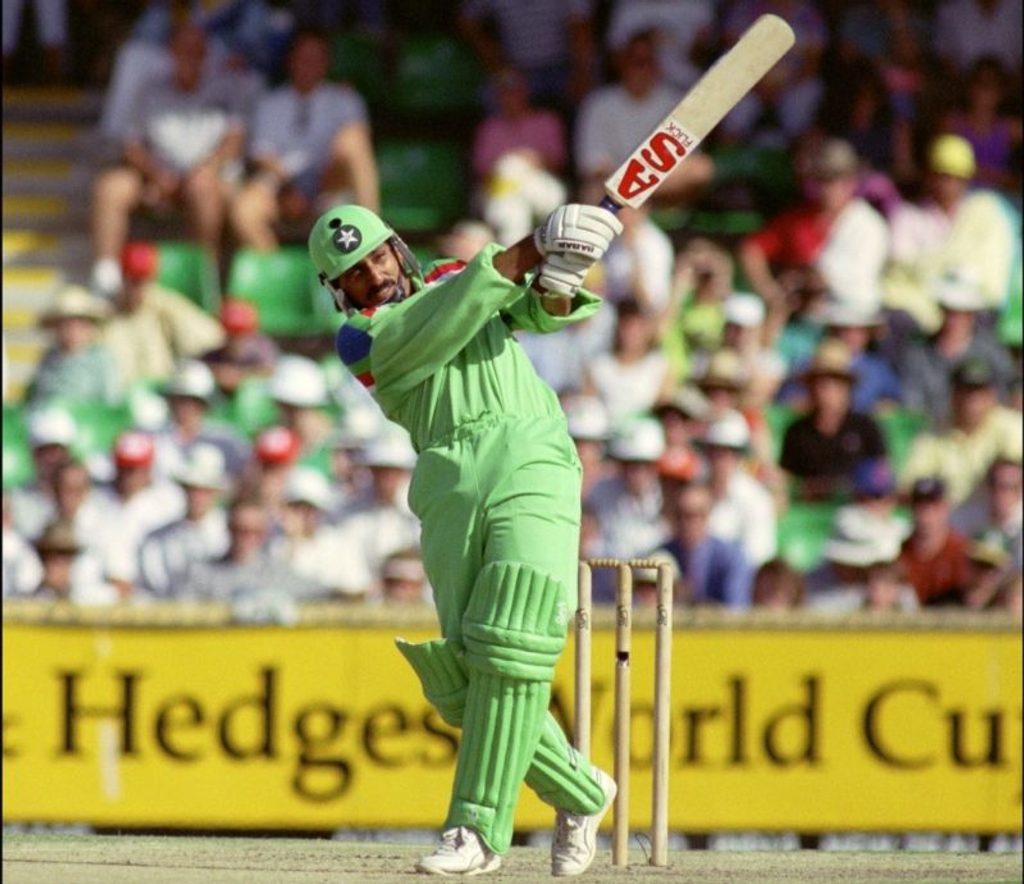 Ramiz Raja batting for Pakistan against Australia during the 1992 Cricket World Cup
Ramiz Raja batting for Pakistan against Australia during the 1992 Cricket World Cup
“If you were jumping 5ft and suddenly you know you have to jump 10ft to save yourself from a kill, you do that. It’s the kind of mechanism that, in a desperate situation, brings out the best in our make-up, and individual brilliance comes through and we look not only to survive but to kill our opponents. The aggressive mechanism within a defensive frame, that comes out and becomes haavi [heavy or overbearing] on the opponent.
“In our time we used to wait for the ball to get old and then ek naara lag jaata tha [a chant went around the team], a feeling on the field that it is happening now, a trigger point. We then had the quality to knock them over. Now it’s a different team altogether and a different opposition and different rules. But the principal mechanism is the same, where in a desperate situation it brings out the best in us. Fielding becomes better and you know you cannot make any more mistakes, that kind of a desperate mindset.”
Where Ramiz sees desperation, Saad sees opportunity. Of course. “It’s a combination of three major national characteristics – laziness, impatience, and latent brilliance. Since we’re lazy, we don’t get engaged until we sense an opportunity. But once we do get engaged, our impatience drives us to get the job done quickly, and our latent capacity for brilliance makes it all happen. Seen another way, we are an enormously gifted team that’s too lazy to apply itself. But when the circumstances are right and an opening appears, our natural gifts take over, with our innate impatience ensuring a speedy resolution.”
What Ramiz is talking about could be an offshoot of a tangible phenomenon which, most popularly, manifests itself in those apocryphal tales of mothers suddenly finding the strength they didn’t know they had to lift cars under which their babies are trapped. In his book Extreme Fear: The Science of Your Mind in Danger, the science journalist Jeff Wise goes deep into this, but one brief extract (prefacing the tale of a man who did lift a car to save a cyclist trapped underneath) is too relevant not to reproduce here.
“Here’s how it is: one minute, you’re going through your daily routine, only half paying attention. And the next you’re sucked into a vivid, intense world, where time seems to move slower, colours are brighter, sounds more perceptible, as though the whole universe has suddenly come into focus.”
In an email discussion, Wise equated this to the idea of the clutch performer. “There’s been a fair amount of debate as to whether there is such a thing as a ‘clutch performer’ – someone who’s so-so most of the time but consistently plays at a markedly better level when forced to come from behind to win a game,” he wrote. “Physiologically, there might be some people who are able to use that rush of adrenaline that comes over us in a high-tension situation and lets us run faster and react more quickly. On the other hand, some argue that this kind of clutch performance is just a statistical fluke, that inevitably sometimes sports people are going to come from behind in the end, and by chance some people will wind up doing so more often.”
***
Listen if you can to “Chori Chori”. An old folk song, it has been reconstructed by Coke Studio, an intelligent and hip Pakistani music show created by the soft-drinks giant which has managed to defy the fact of its own polluting commercialist birth, and produced more freewheeling creative authenticity than could be expected from such a union between art and commerce. Every season – this year will be Coke Studio’s sixth – the creative force behind it, Rohail Hyatt, digs out musicians big, obscure and lost from any scene or tradition, throws them together into a studio with a house band, and has the entire process of creation and final output filmed, recorded and then aired. Broadly, the formula is to mix contemporary sounds of Pakistan with older, more traditional ones. But really there is no formula and it’s not fusion in the Peter Gabriel style of forced fusion. Hyatt has fused sounds from Pakistan with those from elsewhere, from a previous age to this, so organically that he has created something anew.
“Chori Chori” was sung originally by Reshma, one of Pakistan’s greatest folk singers, and is rendered modern by Meesha Shafi. It was once written of Jimmy Connors that he played women’s tennis inside a man’s body; Reshma’s voice could be that of a man inside a woman’s body. Shafi – an elfin, glammed-up Beth Gibbons – is different but no less striking, bringing to the song a sore throat and smoking sexiness. Her voice has pain.
As the song begins to end, about five minutes and 45 seconds in, it does so with a quietly gathering gravitational pull. A gentle auditory whirlpool ropes in the different threads, building a pyramid of sound, higher, narrower. To the listener, vision and sense is tunnelled into nothingness, but in this crashing and mild percussive chaos, everything can actually be seen. When I first heard it, it was an indescribably powerful and briefly paralysing moment. That denouement, the world ending and simultaneously beginning, has become one of the many leitmotifs of Coke Studio: the slow, long build, the gradual bringing together to make one, the swift finish in ecstasy.
To me, this was a partial epiphany because it sounded like the musical and emotional resonance of what Pakistan do. Specifically it pushed me into thinking about Qawwali, even though “Chori Chori” is not Qawwali at all.
Briefly – and dryly – Qawwali is a form of devotional music, originating centuries ago but in the form that we now know it around the 13th century by one order of the Sufis. (Sufism is a practice of Islam but, with its modern puritanism belt much loosened, it asks for a more personalised relationship with God.) Generally but not exclusively, the lyrics will be the work of great Sufi poets, rendered in soaring, shrieking voices but to bare music; a tabla or dhol for a beat, a wheezing harmonium for rhythm and the clapping of an entourage. The voice, the clapping, the chanting: these are the structural planks. But the spiritual base is the most important because Qawwali is not just music. To those versed, it is a call to prayer, to ritual, to contemplation, to faith, to hope, to despair, to love, to mourning, to celebration. Other music, especially modern music, asks you primarily to listen. Qawwali asks that you submit, that you immerse yourself. Otherwise it asks – and gives – you nothing.
Taken casually, it can be a mood thing. Sometimes it’s left me flat, a mish-mash of voice and noise that, to an ear attuned to Western music, is too disparate and incoherent. But sometimes – live especially and, thus, raw – it catches. Maybe it’s the right lyric or the force of repetition but then – forget mind, body and soul – it can set fire to eternity.
The more I thought about it, the more apparent Qawwali became as a revelatory point of reference for Pakistan’s cricket in those spells. Is it too crazy? I spoke to Abu Mohammad, one of the country’s leading Qawwals (better known alongside his brother Fareed Ayaz) about it. I’m not sure that the argument struck him immediately but, by the end of our conversation, as he promised to send me articles from 2005 (when former President Pervez Musharraf, the Pakistan cricket team and Mohammad and his troupe were all in Delhi together) linking Qawwali and cricket, I thought he might have warmed to it.
There were two questions I really wanted to put to him. Could it be said, I asked, that to the uninitiated, a Qawwali can sometimes feel like a living, breathing but random collection of voice and sound until, suddenly at one moment, it surges together. And then transformed, it becomes momentarily a single, powerful force. (Take also, I thought but didn’t ask, the alaap, that sudden vocal burst in a Qawwali. Is that not exactly like a riff of wickets by one bowler from out of nowhere, at odds with everything that has gone before?)
He thought about it a little. “Yes, completely. When Qawwali is being read it takes a little time for it to get warm, to get into line and get going. But there comes a time when a Qawwal and his audience both become like one, they both come to one side together.”
But it was the next question, about haal, that had really gnawed away in my head. The literal meaning of haal is state, as in a state of being, and it can refer to a number of different states. But it has come to be interpreted, more often than not, as one ultimate state of ecstasy, much sought after but rarely achieved, in man’s journey to get closer to God. “In the ecstatic state,” explains Idries Shah in his book Oriental Magic, “Sufis are believed to be able to overcome all barriers of time, space and thought. They are able to cause apparently impossible things to happen merely because they are no longer confined by the barriers which exist for more ordinary people.”
One of the primary objectives of Qawwali is to attempt to bring the performer as well as the listener to haal. Mohammad recites a Sufi poem and then says: “The state of haal is such that if you, God willing, get there in a gathering, after coming back from haal, you will not be able to describe or explain the feeling. This is just that state that only he knows who has experienced it. Haal or wajd [the literal translation for ecstasy] is such a state that comes to that man and takes him to the goal that he has been in search of all his life. Then he is not with himself, he has reached somewhere else.”
Is there a moment in live performances when you can identify that haal has been achieved? “No, no, no. You cannot identify this moment [haal ultimately can only be granted to you, you have no control over its arrival]. Sometimes it is the traditional chant Allah hoo and it happens, sometimes a verse like Dam a dam mast qalandar and it’s there. This is dependent on the individual and their state of existence, the mood of the moment, where their point of thinking is taken from.”
As a relevant aside, Pakistan’s 1992 World Cup triumph was soundtracked by the Qawwali of the late, great Nusrat Fateh Ali Khan. The players listened to him obsessively (on a stereo picked up by Ijaz Ahmed in Singapore on the way there) every day during practice, during lunch breaks, after games, before games. The entire tournament was, for Pakistan, like a Qawwali itself; disparate, floating aimlessly initially before suddenly coming together with such force that they became the best in the world.
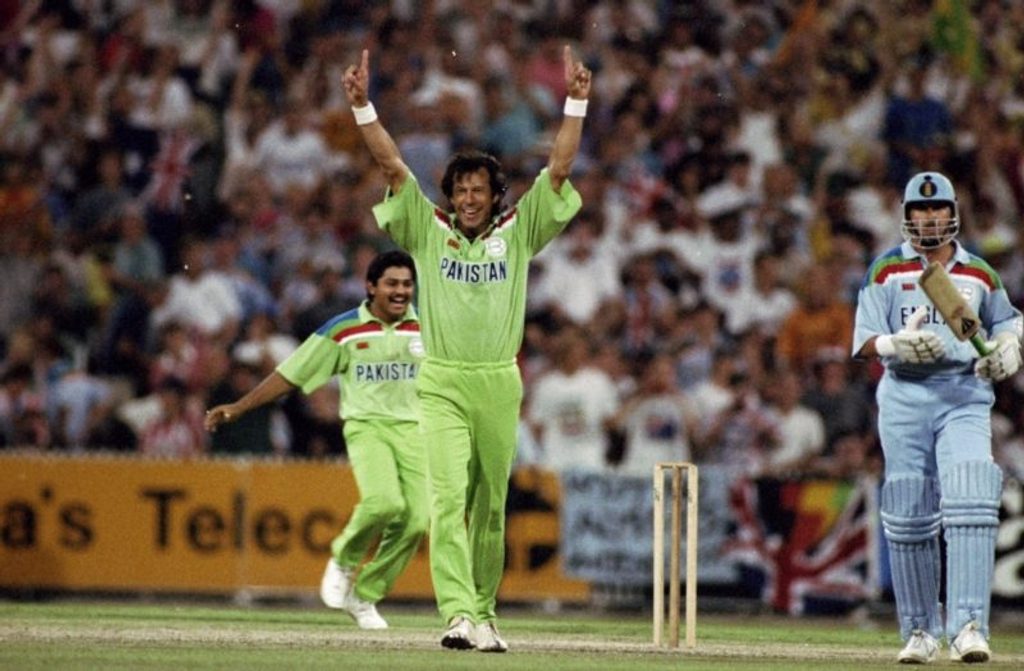 Imran Khan celebrates the final England wicket to win the 1992 Cricket World Cup for Pakistan
Imran Khan celebrates the final England wicket to win the 1992 Cricket World Cup for Pakistan
Mohammad likes cricket and so I put to him that what Pakistan do when they do a Pakistan, when that tamasha erupts, could it be that they have come to haal? “The thing you have said about a team or group spirit, that happens directly, automatically, but not because of them. It happens naturally that they link together as one. You cannot understand how it happens. It happens to you.”
This isn’t so radical a connection because, from the off, the concept of haal struck me as a familiar one. In a way it’s what all athletes strive towards. Only in sports they call it “the zone”, that state of supreme focus which sees athletes perform for periods at the very peak of their potential. How similar is it? Well. Dr Roberta Antonini Phillipe, a sports psychologist at the Institute of Movement Sciences and Sports Medicine, University of Geneva, says that when a player is in the zone, it is like being in a trance.
“The zone is when your mind fully connects with achieving a goal,” she explains. “When you’re in the zone your mind only processes the thoughts and images that help you execute your task successfully. In that state of mind the athlete explains that he has positive thoughts, positive images and sometimes also music in his head.”
The trope that the zone has spiritual components and implications is not unexplored. The psychologist Andrew Cooper did so in his 1998 book Playing in the Zone: Exploring the Spiritual Dimensions of Sports. Cooper is a devout student of Zen. “The zone is the essence and pinnacle of the athletic experience, for it reveals that, at their root, sports are a theatre for enacting the drama of self-transcendence,” he writes. “Athletes and fans alike, focused as we so often are on the game of winning and losing, miss the deeper significance that is right before our eyes. But in the zone, the extraordinary capacities that lie within each individual are made manifest. To grasp this hidden dimension is to transform the very meaning of athletic play.”
Where haal deviates from the zone is in the idea that the latter can be sought, that through a series of steps or rigorous preparation and practice it can be achieved. Many sports psychologists – but not all – believe that using different techniques of visualisation, goal-setting and self-motivation can help athletes to achieve and stay in the zone. Pakistan employs no such techniques and never has done. Just as Abu Mohammad says that Qawwali rehearsed and recorded in a studio is the imprisonment of the form, so it is with Pakistan. Net practice and training – the rehearsed recordings of sport – are generally imprisonment for Pakistani players. That is not where they shine. For them, as with Qawwali, it happens live and it happens unprepared. Enlightenment, goes one saying of Zen, is an accident, as it could be in haal and as it is in Pakistan cricket.
There are other points to consider in Pakistan’s deviation. How often, for example, do you hear of a group of athletes going into the zone collectively? It can and does happen. According to Ed Smith, Mike Brearley recently described a team in a zone: “Each player breathes in the others at their best, is strengthened by that identification, and gives off similar vibes to the rest of the team.” Choking, almost an opposite of the zone, does spread through teams. But the most striking aspect of Pakistan’s haal is the effect it has on the spectator. When Pakistan achieve haal, to be there live is to almost achieve haal yourself, in unison, as is the hope of every performance of Qawwali.
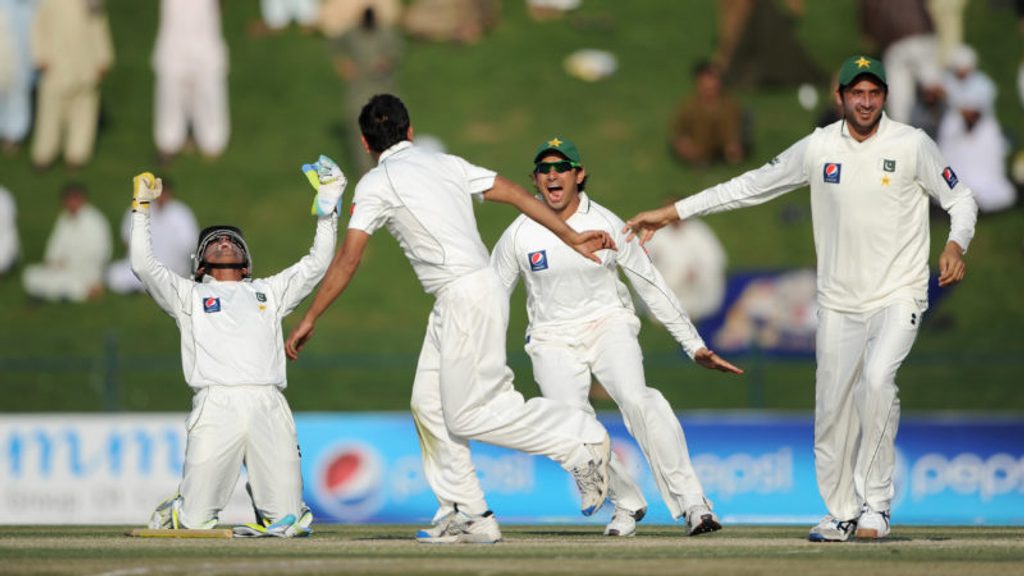 Pakistan celebrate beating England in the second Test in Abu Dhabi, 2012
Pakistan celebrate beating England in the second Test in Abu Dhabi, 2012
The Abu Dhabi Test win over England in January 2012, to pull out just one instance, managed this. I wrote a piece in which briefly I wondered about haal and Sufism. One spectator, part of the English travelling support, read it and wrote in. “As part of the visiting England fan base we sat yesterday in awe of what unfolded. Seldom do you see a side in any form of cricket dismantled in two hours of play. What struck many of us – and we have all played the game throughout our lives – was the seeming inevitability of what was about to unfold. From the very start of the England second innings one could sense a quiet but definite shift in ownership of the moment, something beyond the playing conditions and the participants solely. It was like karma, strange as that may sound. Your article summed up the sense of ‘other worldliness’ some of us felt.”
In other words, submission. Because, finally, what Pakistan are doing in these moments is asking you to submit. They are asking you, opponent and spectator, to submit to their reality, their chaos, their unplanning, their spur of the moment, their pox, their talent, their wretchedness, their beauty, their spirit. They are inviting you to dance with them. Except that it isn’t just a dance. It is the dance of that great Sufi poet, Jalaluddin Rumi:
Dance, when you’re broken open.
Dance, if you’ve torn the bandage off.
Dance in the middle of the fighting.
Dance in your blood.
Dance when you’re perfectly free.
This article was first published in issue 1 of The Nightwatchman in 2013. Buy a hard copy of this article today.








